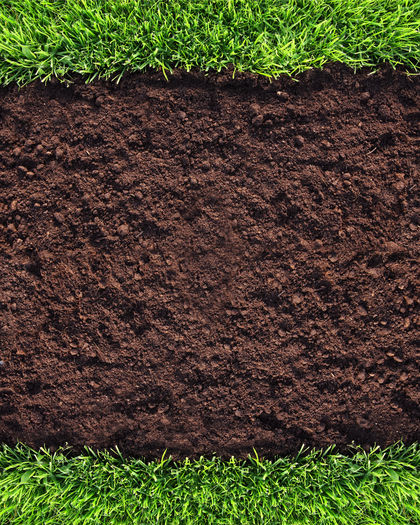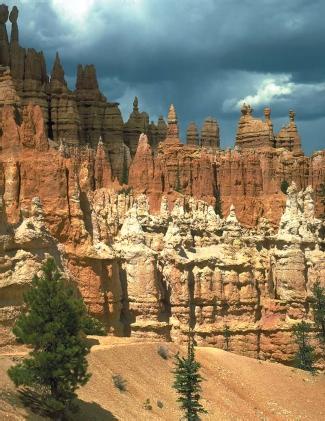Soil

Soil, which covers most of the land surface of Earth, is a complex mixture of weathered rock debris and partially decayed organic (plant and animal) matter. Soil not only supports a huge number of organisms below its surface—bacteria, fungi, worms, insects, and small mammals—but it is essential to all life on the planet. Soil provides a medium in which plants can grow, supporting their roots and providing them with water, oxygen, and other nutrients for growth.
Soil now covers Earth in depths from a few inches to several feet. Soils began to form billions of years ago as rain washed minerals out of the molten rocks that were cooling on the planet's surface. The rains leached or dissolved potassium, calcium, and magnesium—minerals essential for plant growth—from the rocks onto the surface. This loose mineral matter or parent material was then scattered over Earth by wind, water, or glacial ice, creating the conditions in which very simple plants could evolve. Plant life eventually spread and flourished.
As these early plants died, they left behind organic residues. Animals, bacteria, and fungi fed on this organic matter, breaking it down further and enriching the parent material with nutrients and energy for more complex plant growth. Over time, more and more organic matter mixed with the parent material, a process that continues to this day.
Soil is generally composed of 50 percent solid material and 50 percent space. About 90 percent of the solid portion of soil is composed of tiny bits of rock and minerals. These solid particles range in size from fine clay to mid-range silt to relatively large, coarse sand. The remaining 10 percent is made up of organic matter—living plant roots and plant and animal remains, residue, or waste products.
Words to Know
Bedrock: Solid layer of rock lying beneath Earth's surface.
Clay: Portion of soil comprising the smallest soil particles.
Horizons: Layers of soil that have built up over time and lie parallel to the surface of Earth.
Humus: Fragrant, spongy, nutrient-rich material resulting from the decomposition of organic matter.
Leaching: Downward movement through soil of chemical substances dissolved in water.
Loam: Soil that contains a balance of fine clay, medium-sized silt, and coarse sand particles.
Organic matter: Remains, residues, or waste products of any living organism.
Parent material: Loose mineral matter scattered over Earth by wind, water, or glacial ice or weathered in place from rocks.
Sand: Granular portion of soil composed of the largest soil particles.
Silt: Medium-sized soil particles.
Soil profile: Combined soil horizons or layers.
Topsoil: Uppermost layer of soil that contains high levels of organic matter.
The proportion of solid material in soil determines the amount of oxygen, water, and nutrients that will be available for plants. Since smaller particles stick together when wet, soil with a lot of clay holds water well, but drains poorly. Clay particles also pack together tightly, allowing for little air space. As a result, plant roots suffer from a lack of oxygen. Sand particles do not hold water or nutrients well. The best soil for plant growth is one in which all three types of particles—clay, silt, and sand—are in balance. Such a soil is called loam.
Soil horizons and profile
Once soil has developed, it is composed of horizontal layers with differing physical or chemical characteristics and varying thickness and color. These layers, called horizons, each represent a distinct soil that has built up over a long time period. The layers together form the soil profile. Soil scientists have created many different designations for different types of soil horizons. The most basic soil layers are the A, B, and C horizons.
The A horizon, the top layer, includes topsoil. The A horizon generally contains organic matter mixed with soil particles of sand, silt, and

clay. The amount of organic matter varies widely from region to region. In mountainous areas, organic matter is likely to make up only a small portion of the soil, from 1 to 6 percent. In low wet areas, organic matter may account for as much as 90 percent of soil content. Because it contains organic matter, the A horizon is generally darker in color than the deeper layers. The surface of the A layer is sometimes covered with a very thin layer of loose organic debris.
Below the A layer is the subsoil, the B horizon. This layer usually contains high levels of clay, minerals, and other inorganic compounds as water forced down by gravity through the A horizon carries these particles into the B horizon. This natural process is called leaching.
The A and B horizons lie atop the C horizon, which is found far enough below the surface that it contains little organic matter. Fragmented rocks and small stones make up most of the C horizon. Beneath this horizon lies bedrock, the solid layer of rock that lies underneath all soil.
Life in the soil
Soils teem with life. In fact, more creatures live below the surface of Earth than above. Among these soil dwellers are bacteria, fungi, and algae, which exist in vast numbers (bacteria are the most abundant). Three-hundredths of an ounce (one gram) of soil may contain from several hundred million to a few billion microorganisms. These microscopic organisms feed on plant and animal remains, breaking them down into humus, the dark, crumbly organic component of soil present in the A horizon. Humus cannot be broken down any further by microorganisms in the soil. It is a very important aspect of soil quality. Humus holds water like a sponge, serves as a reservoir for plant nutrients, and makes soil particles clump together, helping to aerate the soil.
Ants abound in soils. They create mazes of tunnels and construct mounds, mixing soils and bringing up subsurface soils in the process. They also gather vegetation into their mounds, which become rich in organic matter as a result. By burrowing and recolonizing, ants can eventually rework and fertilize the soil covering an entire prairie.
Earthworms burrow through soils, mixing organic material with minerals as they go and aerating the soil. Some earthworms pull leaves from the forest floor into their burrows (called middens), enriching the soil. Almost 4,000 worms can inhabit an acre of soil. Their burrowing can bring 7 to 18 tons of soil to the surface annually.
Larger animals inhabit soils, including moles, which tunnel just below the surface eating earthworms, grubs, and plant roots. In doing so, they loosen the soil and make it more porous. Mice also burrow, as do ground squirrels, marmots, and prairie dogs. All bring tons of subsoil material to the surface. These animals all prefer dry areas, so the soils they unearth are often sandy and gravelly.
Soil erosion
Erosion is any process that transports soil from one place to another. At naturally occurring rates, land typically loses about 1 inch (2.5 centimeters) of topsoil in 100 to 250 years. A tolerable rate of soil erosion is considered to be 48 to 80 pounds of soil per acre (55 to 91 kilograms per hectare) each year. Weathering processes that produce soil from rock can replace soil at this rate. However, cultivation, construction, and other human activities have increased the rate of soil erosion. Some parts of North America are losing as much as 18 tons of soil per acre (40 metric ton per hectare) per year.
The surface layer of soil (topsoil) provides most of the nutrients needed by plants. Because most erosion occurs on the surface of the soil, this vital layer is the most susceptible to being lost. The fertilizers and pesticides in some eroded soils may also pollute rivers and lakes. Eroded soil damages dams and culverts, fisheries, and reservoirs when it accumulates in those structures as sediment.
[ See also Erosion ]